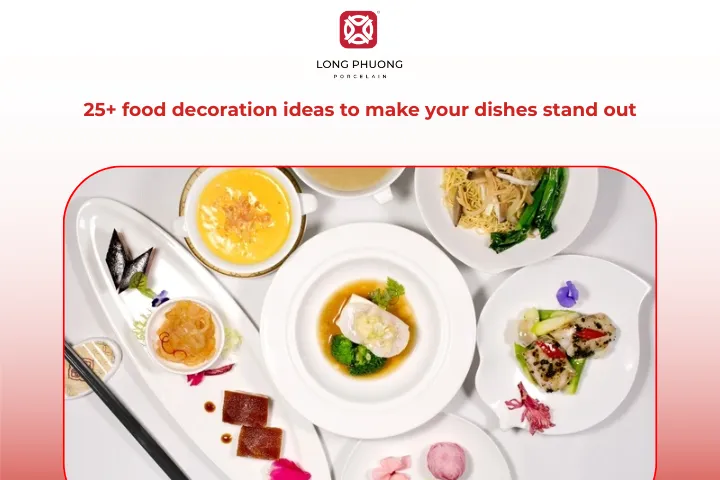Have you ever seen a dish and thought, “Wow, this looks almost too good to eat”? That’s the magic of food decoration. A beautifully decorated dish can instantly make your meals more appealing. In this article, we’ll explore 30+ food decoration ideas that are easy to try at home. Ready to transform your meals from plain to picture-perfect? Let’s dive in.

1. Why food decoration matters
Plating plays a key role in highlighting the final dish. It allows chefs to express their ideas, balance ingredients harmoniously, and create a unique visual appeal. Beyond aesthetics, food decorating also brings several important benefits.
1.1. Influences customer choices
A beautifully plated dish captures attention at first glance and makes customers more eager to try it. Thoughtful presentation creates a strong impression and helps the dish stand out even before it is tasted. Creative ideas not only make the dish more distinctive but also encourage customers to spend more for a better dining experience.
1.2. Reflects food quality
In the Horeca industry, food decorating reflects the quality of the service. A simple but elegant presentation makes the dish look more appealing while ensuring a sense of cleanliness and food safety. Careful and precise plating also shows the professionalism and high standards the restaurant aims to deliver.
1.3. Enhances customer experience
A visually pleasing dish increases excitement and stimulates appetite. Paying attention to details such as clean plates and well-arranged vegetables makes the meal look polished and inviting. When beautifully plated dishes are featured in flyers, catalogs, or online ads, they make a lasting impression and attract customers who want to visit and try the food.
1.4. Helps promote the restaurant
A well-presented dish encourages diners to share their experience. When customers take photos and post them on social media or check in at the restaurant, they create impactful zero-cost marketing. These appealing images draw attention, spark curiosity, and attract new customers who want to experience the restaurant themselves.

2. Basic principles of food decoration
2.1. Keep it simple
Simplicity is the key to creating an enjoyable dining experience. Choose a single garnish or decorative element to keep the plate clean and focused. This approach enhances the look of the dish without distracting or confusing customers about what they are ordering.
2.2. Balance patterns and ingredients
To achieve balance in food presentation, pay attention to how decorative elements and ingredients work together. Colors, shapes, and the overall layout should complement one another to avoid overwhelming diners. A balanced combination of garnish and main ingredients creates a pleasing visual experience.
2.3. Maintain proper portions
Another essential principle is ensuring the right portion size. Adding too little or too much garnish can affect the diner’s appetite and overall impression. Pay attention to the ratio of nutrients, including protein, starch, and fiber. Each serving should be well-balanced, satisfying, and not wasteful.
2.4. Highlight key ingredients
Finally, the main ingredient should always stand out. Focus on placing it in a way that draws attention. Sauces and seasonings can be used to support and enhance the primary component of the dish, making the entire presentation more appealing.

3. 25+ creative and beautiful food decoration ideas
3.1. Decorate food by adding height
Adding height is a popular style used by many chefs. Ingredients are stacked or arranged upward to create height on the plate. This technique gives your dish a 3D effect, making it look more unique.

3.2. Use the clock face style layout
This classic presentation style has been used since the 1960s. Imagine a round plate as a clock. The main protein is placed between the three and nine o’clock positions. Carbohydrates are arranged from nine to twelve o’clock, and vegetables typically go between twelve and three o’clock. This method helps create a balanced and harmonious layout.

3.3. Garnish with chocolate
You can create plenty of simple chocolate decorations that give your desserts a polished, restaurant-style look. Just melt some chocolate, spread it on wax paper, and shape it however you like. Once it firms up, place the pieces on your desserts for an easy and elegant finishing touch.

3.4. Nordic-inspired food decorating
Nordic food decorating focuses on minimalism and open space. The goal is to highlight premium ingredients with a clean and simple design. This style requires skill, precision, and a steady hand, as each element must be placed carefully to achieve a minimalist yet striking appearance.

3.5. Use odd numbers
Arrange items in groups of three, five, or seven rather than even numbers for a more natural and pleasing look. Odd numbers create asymmetry, which is visually appealing and keeps the plate from looking too uniform.

3.6. Combine multiple colors
The basic rule is not to overuse too many colors. Simplicity tends to create a more elegant result. Instead of using many shades, focus on pairing two contrasting colors. For example, a pale green cucumber paired with deep red chili creates a striking contrast that highlights the dish.

3.7. Decorate food with veggie spirals
Vegetables are commonly used to add color and freshness to a dish. Using a spiralizer, you can turn vegetables into fun, curly shapes. Mix colors like zucchini and squash to create eye-catching garnishes that brighten up any plate.

3.8. Plating with multiple sauces
Using different sauces is a popular technique in European cuisine. Chefs often drizzle or paint sauces on the plate to add color and visual patterns, which makes the dish more appealing and enhances the flavor. Common sauces include butternut squash puree, red wine sauce, balsamic sauce, and passion fruit sauce.

3.9. Using edible flowers
Many common flowers are safe to eat and can add a touch of elegance to your dishes. They bring subtle flavor while instantly making any plate more visually appealing. Popular options include daylilies, lilacs, sunflowers, and chrysanthemums.

3.10. Use the rule of thirds
Place your main ingredient slightly off-center rather than dead center. This simple trick creates visual interest and draws the eye naturally across the plate. It’s a classic technique used by chefs to make dishes look more dynamic.

3.11. Layer ingredients
Stacking elements instead of spreading them flat adds depth and dimension. Layer vegetables, proteins, or grains to create a more visually engaging plate. Height can make even a simple dish feel more elegant.

3.12. Decorate food with microgreens
With their small size and bright colors, microgreens add a fresh touch to any dish. Simply sprinkle a few over salads, proteins, or soups to enhance both appearance and texture. They work best when added just before serving to stay crisp and eye-catching.

3.13. Incorporate textures
Mix creamy, crunchy, and soft elements to make the plate visually interesting and inviting. Texture contrast helps highlight each component on the plate. This enhances both the look and the overall eating experience.

3.14. Use symmetry or asymmetry
Choose either balanced symmetry or intentional asymmetry based on the dish. Both of them can create stunning presentations. Experiment to see which arrangement complements your dish best.

3.15. Add edible dusts or powders
Lightly sprinkle cocoa, cinnamon, matcha, or powdered sugar for extra flair. These small touches can highlight texture and create contrast. They work especially well for desserts. Apply with control for best results.

3.16. Experiment with shapes
Cut ingredients into different shapes such as circles, triangles, or abstract forms. Varied shapes add personality, express creativity, and prevent the plate from looking plain. Use them to match the theme of the dish.

3.17. Garnish with zest or peels
Use citrus zest or peels to add color and texture. They provide a fresh touch and enhance the dish’s aroma. Keep them lightweight and neatly placed. These elements make the dish look carefully crafted.

3.18. Use small props for plating
Include ramekins, small bowls, or edible containers to organize ingredients. They help make it easier to separate flavors while giving the plate a professional touch. Use them sparingly to keep the plate cohesive.

3.19. Finish with a touch of shine
Apply a light glaze, oil, or syrup to bring freshness to the surface. Shiny elements reflect light and make the food look more appealing. Use this as the final step before serving. It enhances the presentation without altering the flavor too much.

3.20. Create geometric arrangements
Organize ingredients into triangles, circles, or linear patterns. Geometric layouts make your plate look intentional and aesthetically pleasing, adding visual order without taking away from natural food shapes.

3.21. Decorate food with a tomato rose
With a little practice, you can turn a cherry tomato into a beautiful rose. Simply peel the tomato in a long spiral, then curl and pinch the peel to form the shape of a flower. It’s a simple way to add a decorative touch to salads, meat trays, and many other dishes.

3.22. Create individual servings
Single-serving dishes have become more popular as people look for safer, more convenient options. Serving food this way can make guests feel at ease while letting you present each dish in a stylish, eye-catching way.

3.23. Garnish with edible glitter
Many baking supply stores carry edible glitter that’s safe to eat. You can sprinkle it on desserts, mix it into drinks, or use it to decorate cookies for a fun, sparkly touch.

3.24. Use colored sugars
Colored sugar is an easy way to add shine and color to cookies, cupcakes, and other sweets. Grab a variety of shades to make your treats more playful and eye-catching.

3.25. Decorate food with spun sugar
For a simple yet elegant decoration, try making spun sugar. It takes a bit of practice, but once you get the hang of it, it can give your desserts a refined, impressive look.

4. Important notes for decorating food
4.1. Choosing the right plate
4.1.1. Choosing the right plate shape
Decorating food on a round plate
Round plates are among the most commonly used today, making them easy to work with for attractive food presentation. Focus the food in the center to highlight the main ingredient, or arrange it in a corner, around the edges, or evenly across the plate. This style makes the dish look more prominent, adds depth, and creates a visually appealing and inviting presentation.
Decorating food on a square or rectangular plate
Plating food on square or rectangular plates can create different visual effects depending on the arrangement. Since the plate shape is already striking, simply line up the food along its length. You can use garnishes such as leafy greens, fruits, seeds, or herbs around the edges to enhance the presentation. Avoid leaving empty corners, as this can make the dish look incomplete or less appealing.
Decorating food on an oval plate
Compared to rectangular plates, oval plates have softer, elongated shapes, making them ideal for longer dishes that take up more space. Arrange the food along the length of the plate, keeping the focus in the center. Use carved vegetables around the edges to fill empty spaces. Oval plates are often used for stir-fried or fried dishes with sauces, such as fish or squid.
Decorating food on a leaf-shaped plate
Leaf-shaped plates are unique but very popular, especially for adding variety to a table setting. These plates feature a central vein, and placing the food along this vein draws attention and makes the presentation more visually appealing.
Decorating food on a seashell-shaped plate
Like leaf-shaped plates, seashell-shaped plates have a unique design with beautiful, wavy edges. They are perfect for serving sweets or fruit. When plating on a seashell-shaped plate, keep the food centered to highlight the plate’s elegant curves.
Decorating food on a boat-shaped plate
Boat-shaped plates are unique, modern, and highly aesthetic. They are often used in Japanese restaurants for serving sashimi or salads. With their elongated shape, simply arrange the food along the length of the plate, leaving no space.

4.1.2. Choosing the right plate size
In European-style dining, larger plates with smaller portions are often preferred, while in Asian cuisine, diners usually enjoy fuller, more generous presentations. A plate that is too large can make the portion look small, while a plate that is too small leaves little room for decorative elements if the portion is large. Choosing the right plate size is essential for balancing portion size and creating an attractive presentation.

4.1.3. Choosing the right plate color
Combining colors harmoniously on the dish is just as important as choosing the right plate size. Bright and colorful dishes are more appealing, but avoid using too many colors at once. White plates with subtle patterns are a safe choice, creating a balanced table setting while remaining healthy and visually pleasing.

4.2. Keep your workspace clean
A clean area helps you stay focused and makes decorating easier. Wipe away crumbs or spills before placing your elements on the plate. A tidy background also keeps your design from looking messy. It allows every detail to stand out clearly.

4.3. Use tools for precise details
Simple tools like squeeze bottles, small spoons, piping bags, or tweezers can give you better control. These tools help you place sauces, herbs, or garnishes exactly where you want them. The more precise you are, the more professional your plate looks. Even small adjustments can make a big difference.

4.4. Leave about 50% of the plate empty
To create a comfortable dining experience, leave about 50% of the plate empty. This allows diners to enjoy each element of the dish without feeling overwhelmed. Using a larger plate can also make the portion feel more satisfying.

4.5. Consider the amount of garnish
Avoid adding too many decorative elements on a plate, as this can disrupt balance and make the presentation look cluttered. Simplicity often creates a more appealing look. Also, remember the rule of odds, a technique many professional chefs use to create a striking focal point.

4.6. Think about flavor balance
Food decoration should not only look good but also support the taste of the dish. Choose elements that add freshness or color without overpowering the main flavor. Good food decorating blends beauty with purpose. When flavors and visuals match, the dish feels more complete.

4.7. Start small and simple
You don’t need to go overboard. Even a small garnish, a drizzle of sauce, or a sprinkle of herbs can dramatically improve the look of a dish. Focus on one or two elements at a time instead of trying to do everything at once.

4.8. Experiment and practice
Don’t be afraid to try new food decoration ideas. Experimenting allows you to discover what works best for different dishes and helps you develop your own style. The more you practice, the more confident and creative you’ll become in decorating food. Treat each plate as an opportunity to learn and refine your skills.

5. Beautiful food decoration images
If you want to make your meals more appealing, take a look at the following images of beautiful food decoration. These food decoration ideas can help you create visually stunning meals while showcasing your creativity and attention to detail.





6. Video on how to decorate food beautifully
7. Where to buy plates in various styles and designs
If you are looking for round, square, rectangular, leaf-shaped, seashell-shaped, or boat-shaped plates to create beautiful food presentations, Long Phuong Porcelain is the place to go. With 20 years of experience in manufacturing and selling household porcelain, Long Phuong offers a wide range of plates in various shapes and sizes.

8. FAQs
8.1. What are the trending food decorations?
Microgreens, edible flowers, and minimalist plating are currently popular. Chefs also favor natural textures, seasonal ingredients, and artistic sauce drizzles. Clean presentation with bold color contrast is a major trend in modern plating.
8.2. What are the different styles of food decoration?
Common styles include classic (symmetrical), minimalist, rustic, linear, and modern artistic plating. Some dishes use Japanese-style balance or Nordic simplicity. Each style focuses on color harmony, layout, and how the main ingredient stands out.
8.3. What are food decorations called?
They are generally referred to as garnishes. Depending on the type, they may be called microgreens, zest, coulis, edible flowers, or dusting powders. Garnishes should enhance both visual appeal and flavor.
8.4. How to decorate a platter of food?
Choose a neat base and plan your layout before placing ingredients. Group items neatly, use height and contrasting colors, and leave some empty space. Finish with fresh garnishes added right before serving for the best look.
9. Conclusion
Above, Long Phuong Porcelain has shared 25+ food decoration ideas that make your dishes look more engaging. We hope you find this article helpful. Enjoy decorating stunning meals for your family! Don’t forget to visit our website to explore a wide range of high-quality household porcelain.
CEO of Long Phuong Group Joint Stock Company, with more than 20 years of exploration and research to obtain the best formulas and professional experience, Long Phuong Porcelain has produced more than 400 designs of all kinds of household porcelain, Significant contributions to Vietnam's ceramic industry.
 Vietnam
Vietnam
